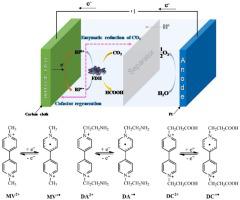Journal of CO2 Utilization ( IF 7.2 ) Pub Date : 2021-08-19 , DOI: 10.1016/j.jcou.2021.101679 Zhibo Zhang 1 , Tudor Vasiliu 2 , Fangfang Li 1 , Aatto Laaksonen 1, 2, 3, 4 , Francesca Mocci 5 , Xiaoyan Ji 1

|
Enzymatic reduction of CO2 to formic acid with the enzyme formate dehydrogenase (FDH) and a cofactor is a promising method for CO2 conversion and utilization. However, the natural cofactor nicotinamide adenine dinucleotide (NADH) shows some drawbacks such as a low reduction efficiency and forms isomers or dimers (1,6 - NADH or NAD dimer) in the regeneration reaction. To overcome them and to improve the production of formic acid, in this work, the artificial cofactors, i.e., the bipyridinium-based salts of methyl viologen (MV2+), 1,1’-dicarboxymethyl-4,4’-bipyridinium bromine (DC2+), and 1,1’-diaminoethyl-4,4’-bipyridinium bromine (DA2+), were used to replace NADH, and the effect of different functional groups on the electrochemical regeneration and catalytic performance in the enzymatic reaction was studied systematically. Also, studies using the natural cofactor NADH were carried out for comparison. It was found that the cofactor with amino groups showed the highest catalytic efficiency (kcat/Km) of 0.161 mM-1min-1, which is 536 times higher than that of the natural cofactor NADH. Molecular Dynamics simulations were conducted to give further molecular insight into the behavior of the cofactors. Analyzing the free energy profiles of the complexes between CO2 in the FDH active site with different artificial cofactors indicated that the artificial cofactor with the amino groups had the highest affinity for CO2, being consistent with the experimental observations.
中文翻译:

电化学驱动的 CO2 与人工辅助因子有效酶促转化为甲酸
使用甲酸脱氢酶 (FDH) 和辅因子将 CO 2酶促还原为甲酸是一种很有前景的 CO 2转化和利用方法。然而,天然辅因子烟酰胺腺嘌呤二核苷酸(NADH)显示出一些缺点,例如还原效率低,并在再生反应中形成异构体或二聚体(1,6-NADH或NAD二聚体)。为了克服它们并提高甲酸的产量,在这项工作中,人工辅助因子,即甲基紫精 (MV 2+ )的联吡啶盐、1,1'-二羧甲基-4,4'-联吡啶溴(DC 2+ ) 和 1,1'-diaminoethyl-4,4'-bipyridinium bromine (DA 2+),取代NADH,系统研究了不同官能团对酶促反应中电化学再生和催化性能的影响。此外,还进行了使用天然辅因子 NADH 的研究以进行比较。发现具有氨基的辅因子表现出最高的催化效率(k cat / K m),为0.161 mM -1 min -1,是天然辅因子NADH的536倍。进行分子动力学模拟以提供对辅因子行为的进一步分子洞察。分析 CO 2之间配合物的自由能分布在FDH活性位点中,人工辅因子的不同表明具有氨基的人工辅因子对CO 2 的亲和力最高,与实验观察一致。











































 京公网安备 11010802027423号
京公网安备 11010802027423号